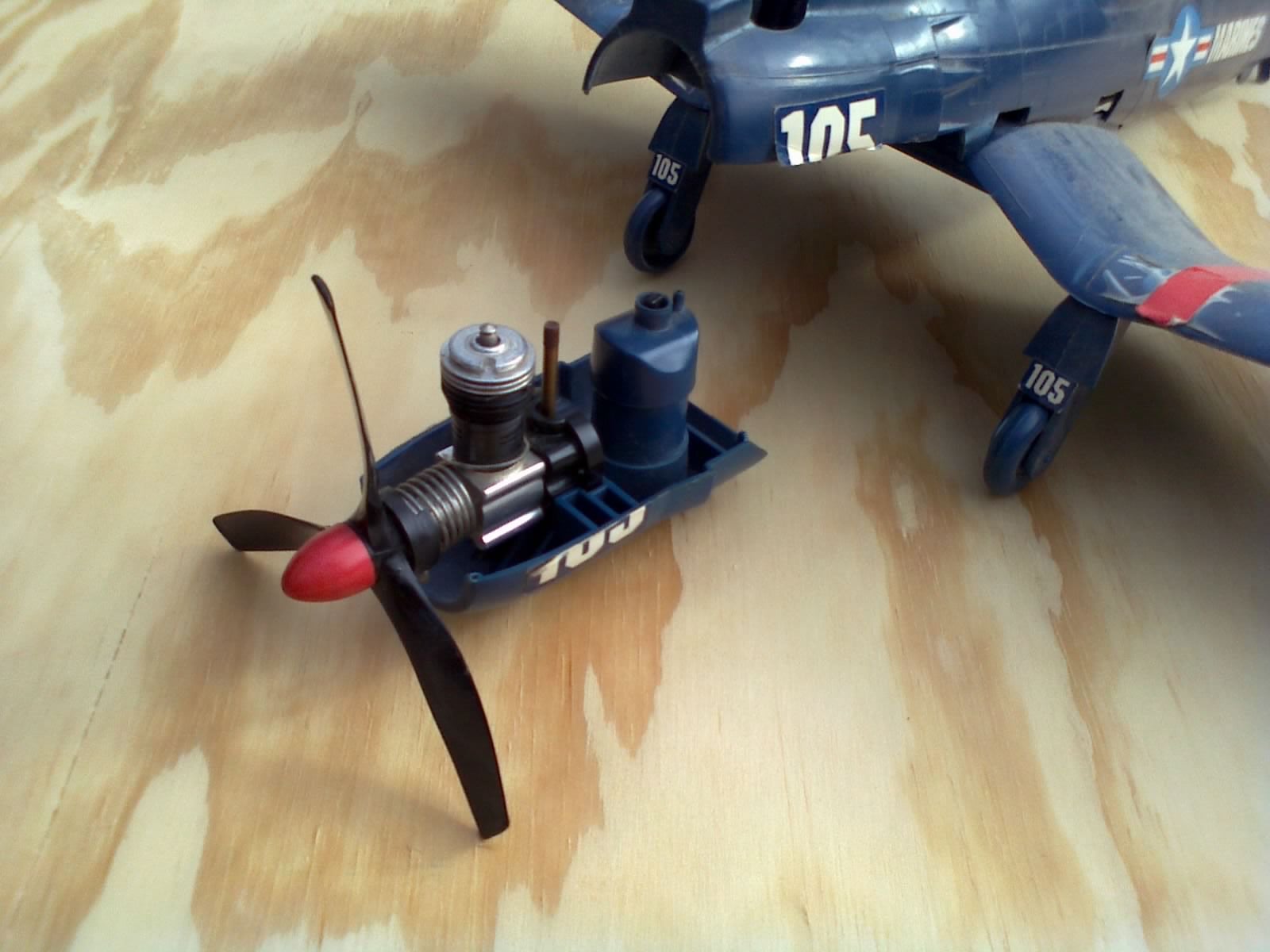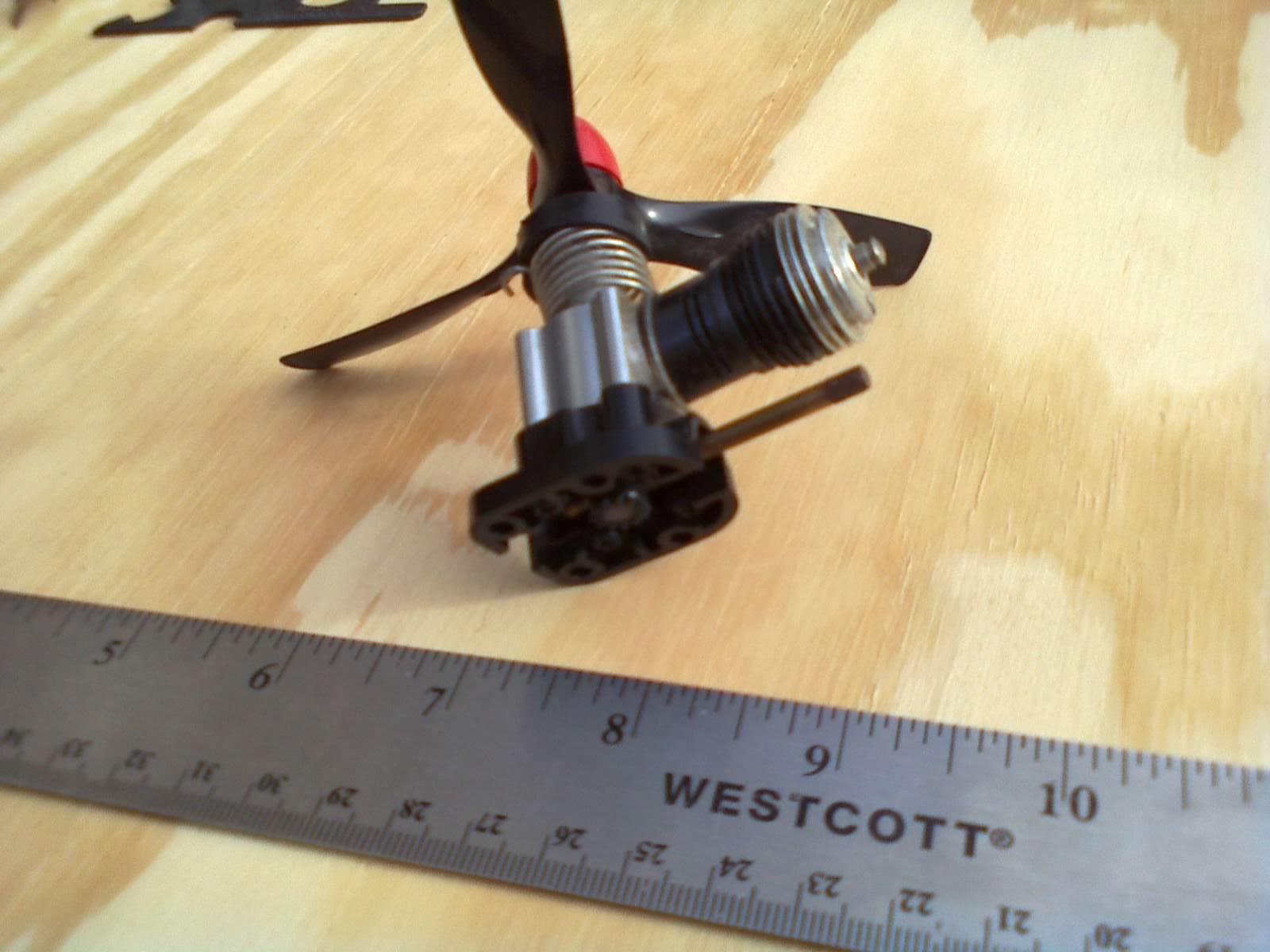 "Urambo Tauro" (urambotauro)
"Urambo Tauro" (urambotauro)
11/14/2016 at 12:00 • Filed to: The little engine that could, corsair, model airplane, hobby plane, cox, wrenching, discussion
 1
1
 11
11
 "Urambo Tauro" (urambotauro)
"Urambo Tauro" (urambotauro)
11/14/2016 at 12:00 • Filed to: The little engine that could, corsair, model airplane, hobby plane, cox, wrenching, discussion |  1 1
|  11 11 |

what do you do with a .8cc engine, what do you do with a .8cc engine earl-eye in the marnin’?
!!!error: Indecipherable SUB-paragraph formatting!!! reminded me of a control-line plane I received for Christmas when I was a boy. I was kind of a plane geek at the time, but I never did get it running, always more interested in my Legos.
Every once in a while I would spin the prop with my fingers with a mild curiosity. But as the years went by, I just forgot about it altogether. Some of the parts disappeared, but I knew that I had at least kept the engine just because it was neat. While digging through some old boxes this weekend, I found this!

I turns out, not only did I keep the engine, but most of the plane is still with it!
I started looking around online to try to identify it and refresh my memory on what else is missing. Here are some pics I found that show what the complete kit looks like. (Wow, I never thought I’d see this stuff again!)


I’ve learned that this 1:27 scale Corsair is made by Cox, and is powered by what !!!error: Indecipherable SUB-paragraph formatting!!! identifies as a “late model thick wall cylinder with slit exhaust and a single bypass booster” .049 cu in (.8cc) engine.
Now I’ve never been into RC or line-control toys like this, so hobby engines are new territory for me. But I took a close look at it and there’s really not much to it.

The fuel tank gravity-feeds to the air inlet. At that point, there is a single fuel adjustment screw, after which it feeds directly into the crankcase, probably to lubricate the bottom end before going to the cylinder. There are passages in the cylinder wall where the mixture can enter the chamber when the piston reaches the bottom of its stroke.
Also at the bottom of the stroke are slits in the cylinder wall open to outside air. This must be the “slit exhaust” mentioned in the Wikipedia article.
At the top of the cylinder is a glow plug head, but this isn’t a diesel (and it’s certainly not petrol-powered). Apparently it takes “nitro” fuel, which is something I’ll have to find. There is a slight chance that I still have the unopened can of “Super Power Fuel” somewhere around, but I’m not sure it would still be any good.
I still have the glow plug wires, but without the battery case, I’ll have to rig up a power source.
The instructions I had are long gone too, but I managed to find !!!error: Indecipherable SUB-paragraph formatting!!! , and I think that this engine is probably a “Killer Bee”. Here’s a pleasant video (James May, is that you?) I found on YouTube showing just how simple the assembly is:
Now, the fuselage of my Corsair no longer has its rear stabilizer, so I won’t be flying it. But the engine is still “new” and undamaged. I’ll probably throw the rest of the plane in the trash, but !!!error: Indecipherable SUB-paragraph formatting!!! gives me hope that the engine might be worth something.
Not sure if I want to sell it, though. I want to at least fire it up and... well, I dunno. I thought about a desk toy, but it might be too !!!error: Indecipherable SUB-paragraph formatting!!! for that. Any ideas, Oppo?
 Mattbob
> Urambo Tauro
Mattbob
> Urambo Tauro
11/14/2016 at 12:05 |
|
you could easily use this as a power source for an RC controlled project. Maybe a boat!
 LongbowMkII
> Urambo Tauro
LongbowMkII
> Urambo Tauro
11/14/2016 at 12:12 |
|
LS swap.
 TheHondaBro
> Urambo Tauro
TheHondaBro
> Urambo Tauro
11/14/2016 at 12:13 |
|
inb4 Put it in a Honda
 BorkBorkBjork
> Urambo Tauro
BorkBorkBjork
> Urambo Tauro
11/14/2016 at 12:15 |
|
Gas powered alarm clock?
 Cé hé sin
> Urambo Tauro
Cé hé sin
> Urambo Tauro
11/14/2016 at 12:17 |
|
Pencil sharpener.
 jimz
> Urambo Tauro
jimz
> Urambo Tauro
11/14/2016 at 12:33 |
|
glow fuel doesn’t necessarily have to be “nitro.” the methanol is the important part; the hot platinum wire acts as a catalyst and initiates combustion under compression. some FAI-compliant airplane fuel has no nitromethane, it’s strictly methanol and oil, usually castor.
and you don’t want to use more nitromethane than the engine is designed for. Nitro is a power boosting component, which creates more heat and pressure. Plus, it’s hilariously prone to detonation so if the compression ratio is too high, it’ll lead to pitting of the piston crown and combustion chamber and break or vaporize the glow plug wire.
we use 50-65% nitro fuel in racing boats, but we have water cooling and have to machine out the combustion chamber to lower the compression. plus the more nitro you add, the richer you have to set the needle. a boat running 50% nitro can burn through 24 oz. of fuel in about 4 minutes.
 Urambo Tauro
> jimz
Urambo Tauro
> jimz
11/14/2016 at 12:44 |
|
From what I’ve been reading, I need at least 20% castor oil in the mix, and no more than 50% nitromethane. I was surprised to read that synthetics are a no-no. I could start using racing fuel after break-in, but I don’t think I will. I’ll probably just try to find some of that “Super Power Fuel” like it was originally packaged with and stick with that.
 jimz
> Urambo Tauro
jimz
> Urambo Tauro
11/14/2016 at 13:11 |
|
yeah, those Cox engines have little metal so they run hot and have loose tolerances when cold. plus the pistons have no rings so you need a lot of (sticky) castor oil to provide a seal.
I’d just take it to a place like Prop Shop in Warren and ask for a fuel suitable for those engines. They even have Cox fuel.
http://www.propshophobbies.com/ProductDetails.asp?ProductCode=COXP1005
 Urambo Tauro
> jimz
Urambo Tauro
> jimz
11/14/2016 at 13:33 |
|
That’s the stuff! I’m gonna check with Flightline over on Baldwin (closer to me) later on and see if they’ve got any.
 TheRealBicycleBuck
> Urambo Tauro
TheRealBicycleBuck
> Urambo Tauro
11/14/2016 at 13:58 |
|
It’s amazing how versatile the little “oh four nine” engines were. My introduction to them was as a power source for lofting r/c gliders when we didn’t have a high-start available. High-starts were basically giant rubber bands made from surgical tubing. A power pod would get it aloft, but did provide some drag once the engine stopped, so it was a compromise. It also left residue on the plane which had to be cleaned off.

After cutting my teeth on gliders, I bought a much larger plane for learning true powered flight. The next time I put an 0.049-powered machine into the air, it was a GLH (Goes Like Hell) pylon racer. The real challenge with the GLH was a complete lack of a throttle and the poor glide ratio once the engine ran out of fuel. That plane was exhausting to fly. (Disclaimer: neither image is mine.)

 Spoon II
> Urambo Tauro
Spoon II
> Urambo Tauro
11/14/2016 at 14:12 |
|
I wonder how hard it would be to add some tiny servos to that guy. Instant RC plane